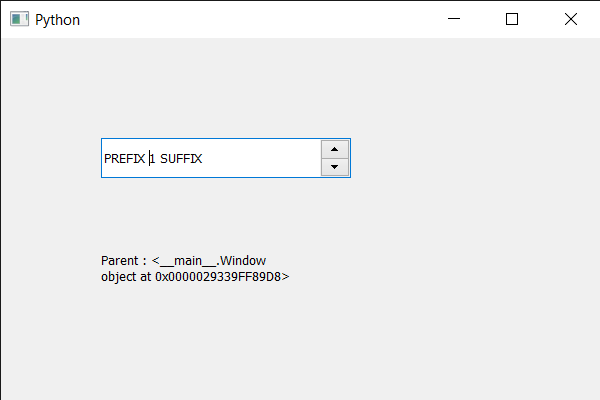En este artículo veremos cómo podemos obtener el padre del cuadro de número. Cada widget tiene algún elemento principal, por ejemplo, el elemento secundario del cuadro giratorio es la edición de línea y el elemento principal de edición de línea será el cuadro giratorio en sí.
Para hacer esto, usamos parentel método con el objeto de cuadro de número.
Sintaxis: spin_box.parent()
Argumento: no requiere argumento
Retorno: Devuelve el objeto padre
A continuación se muestra la implementación.
# importing libraries
from PyQt5.QtWidgets import *
from PyQt5 import QtCore, QtGui
from PyQt5.QtGui import *
from PyQt5.QtCore import *
import sys
class Window(QMainWindow):
def __init__(self):
super().__init__()
# setting title
self.setWindowTitle("Python ")
# setting geometry
self.setGeometry(100, 100, 600, 400)
# calling method
self.UiComponents()
# showing all the widgets
self.show()
# method for widgets
def UiComponents(self):
# creating spin box
self.spin = QSpinBox(self)
# setting geometry to spin box
self.spin.setGeometry(100, 100, 250, 40)
# setting range to the spin box
self.spin.setRange(1, 999999)
# setting prefix to spin
self.spin.setPrefix("PREFIX ")
# setting suffix to spin
self.spin.setSuffix(" SUFFIX")
# creating a label
label = QLabel(self)
# making the label multi line
label.setWordWrap(True)
# setting geometry to the label
label.setGeometry(100, 200, 200, 60)
# getting parent
value = self.spin.parent()
# setting text to the label
label.setText("Parent : " + str(value))
# create pyqt5 app
App = QApplication(sys.argv)
# create the instance of our Window
window = Window()
# start the app
sys.exit(App.exec())
Producción :
Publicación traducida automáticamente
Artículo escrito por rakshitarora y traducido por Barcelona Geeks. The original can be accessed here. Licence: CCBY-SA